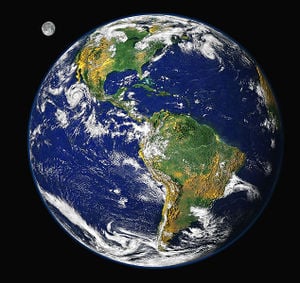
The biophysical environment is the symbiosis between the physical environment and the biological life forms within the environment, and includes all variables that comprise the Earth's biosphere. The biophysical environment can be divided into two categories: the natural environment and the built environment, with some overlap between the two. Following the industrial revolution, the built environment has become an increasingly significant part of the Earth's environment.
Constituents[edit | edit source]
The scope of the biophysical environment is all that contained in the biosphere, which is that part of the Earth in which all life occurs. A biophysical environment is the complex of biotic, climatic, and edaphic factors that act upon an organism and determine its form and survival, and morphs itself in the process. Ecosystems, of which there are numerous types and are a defined part of the biosphere, collectively make up the whole of the biosphere. Within an ecosystem there are habitats in which an organism (including human beings) exists. At its most natural state, an environment would lack any effects of human activity, although the scale of this activity is such that all areas of the Earth have had at least some influence by humans. At the other end of the scale is the built environment and in some cases it has the biotic component that is virtually absent.
The biophysical environment can vary in scale from microscopic to global in extent. They can also be subdivided according to their attributes. Some examples may be the marine environment, the atmospheric environment and the terrestrial environment.[1]
Environmental science[edit | edit source]
Environmental science is the study of the interactions within the biophysical environment. Part of this scientific discipline is the investigation of the effect of human activity on the environment. Ecology, a sub-discipline of biology and a part of environmental sciences, is often mistaken as a study of human induced effects on the environment. Environmental studies is a broader academic discipline that is the systematic study of interaction of humans with their environment. It is a broad field of study that includes the natural environment, built environments and social environments.
Environmentalism is a broad social and philosophical movement that, in a large part, seeks to minimise or eliminate the effect of human activity on the biophysical environment. The issues of concern for environmentalists usually relate to the natural environment with the more important ones being climate change, species extinction, pollution and old growth forest loss.
See also[edit | edit source]
- Environment
- Natural environment
- Biophysics subject to the context
- Conservation (disambiguation)
- Index of environmental articles
- List of conservation topics
- List of environmental issues
- Lists of environmental topics
References[edit | edit source]
- ↑ Kemp, David (1998). Environment Dictionary. London, UK: Routledge.
Bibliography[edit | edit source]
- Miller, G. Tyler (1995). Environmental science. California: Wadsworth. ISBN 0-534-21588-2.